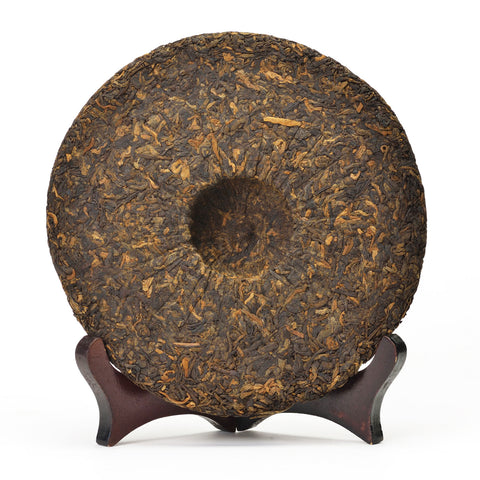There are two variations of Pu-erh tea: Sheng Pu-erh (the raw or green type) and Shou Pu-erh (the ripe or black type).
Both Shu and Sheng Pu-erh teas are usually made of Camellia sinensis var. assamica. After fermentation and roasting, pu-erh tea is aged, often for many years, resulting in its dark color and bold, mellow flavor.
What Is The Difference Between Raw And Ripe Pu-erh?
Raw (Sheng) Pu-erh is made from mao cha that was picked, quickly roasted, sun-dried and then steamed to be compressed into round disks called cakes. After which the cakes are aged until the tea’s taste is properly transformed.
Because raw pu-erh doesn’t go through the piling process, it retains a fresh scent as well as a little bit of astringency, with a sweet aftertaste.
Ripe (Shou) Pu-erh. At first, shu pu-erh goes through the exact same steps as the sheng pu-erh. However, at the stage of producing the cakes it undergoes the following procedure, called ‘Wet Piling’ (渥堆 – Wo Dui):
- the leaves get piled up to a certain height that is usually around 70 cm, but different tea masters have their own preferences.
- the piled tea gets wetted with water, and then coved by a linen cloth. This step allows the tea to stay warm and creates a humid environment to accelerate the fermentation.
- after the tea ferments to a certain degree, it gets unpiled and ventilated.
Our Fengqing GuShu Chun Jian Raw Pu-erh, 2012
How Does Aging Affect Pu-erh?
For Raw Pu-erh:
- aging adds complexity as the tea keeps on fermenting over the years and with each year its taste keeps transforming, losing bitterness and gaining new notes
- higher grade raw mao cha can significantly benefit from aging, although many pu-erh enthusiasts believe that there is a cap to the aging which cuts off at around 25 years, after which the taste doesn’t change much
For Ripe Pu-erh:
- the tea gets fermented in an accelerated way, and then, as it is aging, it is ventilating and getting rid of all those unwanted notes coming from the wet piling and the fermentation process. In other words, its taste gets cleaner but doesn’t gain in complexity.
- it is generally believed that there is no need to age ripe pu-erh any more than 10 years
What Is Chen Wei?
Chen Wei (陈味) – "Old Flavor", is a Chinese term used to describe the distinct taste that a tea develops after being aged. It is something that is sought after in well-aged pu-erh. Chen Wei ultimately means the tea will taste smoother and more mellow, which is why many describe a lightly aged sheng pu-erh as being too sharp and potent.
Our Fengqing Zhou Shi Ripe Pu-erh Tea Cake, 2018
Older Pu-erh = Better Taste?
Many of us were lead to believe that it is reasonable to pay an extremely high price for a pu-erh aged 20+ years. Most often it is actually unreasonable.
In fact, older age does not equal better taste, and although there are some longer-aged pu-erhs out there with an exceptional taste, in general, this should not be your area of focus when looking to buy a delicious cake.
Think about it the same way you would think about wine, similarly not all wine benefits from aging.
Another common problem that arises with pu-erh is something many of us have experienced as the fish taste.
To make it clear, your pu-erh should not be tasting like fish.
Usually, this exact fish taste means that the pu-erh was aged under bad conditions. This means that a high-quality mao cha aging could have gone terribly wrong due to humidity, extreme temperature changes, dusty storage rooms and more. After the aging process has gone wrong, there is virtually no way to reverse it. Always try to buy your pu-erh from reputable sources and be wary of suspiciously low prices.
When Is It Beneficial To Age Pu-erh Longer?
To determine whether or not the final product would have benefited with aging we first have to look at our raw product - mao cha, from which all pu-erh is made from.
Similarly, as when we look at all other teas, the final product will differ based on so many factors:
Which leaves were picked — new leaves and buds or the older bigger leaves? When was it picked? How was it picked? What is the condition of the soil? Were pesticides used? And so many more!
The tea that usually benefits from aging is raw pu-erh made from high-quality mao cha. Rarely will aging benefit a ripe pu-erh.
How Does The Taste Transform With Age?
Ultimately as many people as there are who enjoy drinking pu-erh, so the many opinions there will be. There are quite a lot of people who love the fresh, slightly astringent taste of a young pu-erh, as much as there are people who love the mellow, flowing taste of an aged pu-erh.
In general, as the tea ages, it will change each time showcasing a new flavor profile. Young pu-erhs that are only aged for a few years show a sweet floral taste. After about 5 years the tea turns more fruity, and then at 10+ it will start developing a deeper dried-fruits and nuts flavor profile. Quite like wine!
After having the proper information to know what to look out for when trying pu-erh we invite you to sample both shou and sheng pu-erh of different aging periods, and with more experience learning which exact flavor profiles attract you most!
If you are new to pu-erh, or if you are looking to find a cake you like, we recommend checking out our Pu-erh Teas Section which holds carefully curated samples of both shou and sheng pu-erh.

